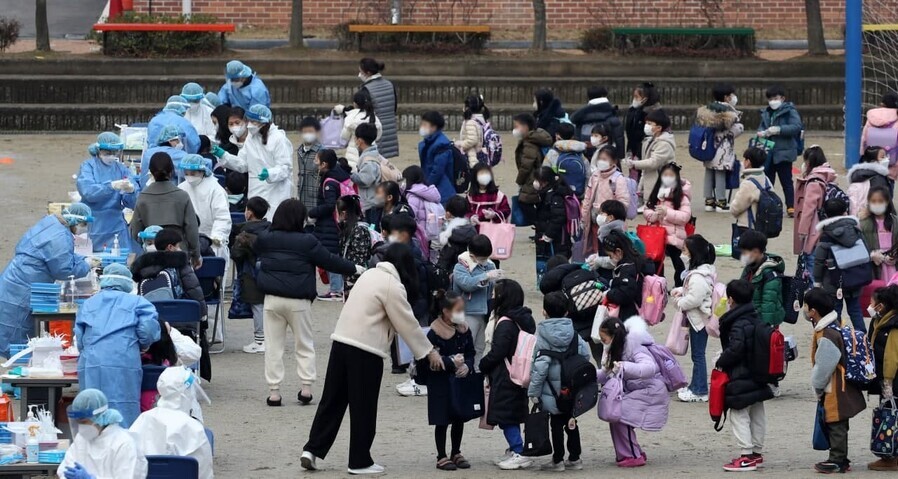hankyoreh
Links to other country sites 다른 나라 사이트 링크
COVID-19 cases are skyrocketing among school-aged children in S. Korea

Cases of COVID-19 are rapidly increasing among South Korean children of elementary school age, who have yet to be vaccinated against the virus. As the weekly tally of infected children is increasing by nearly 1,000 with each passing week, transmission within the family is thought to be driving the upsurge in young patients.
According to data about COVID-19 patients aged 7-12 that was released by Korea’s Central Disease Control Headquarters on Tuesday, 4,325 people in that age group tested positive for the disease in the third week of December (Dec. 12-18). That was 135% higher than in the fourth week of November (Nov. 21-27), where there were 1,835 new cases in that category.
The number of new cases among people aged 7-12 has been rapidly growing since the fourth week of November, rising in each subsequent week from 1,835 to 2,470, then 3,721 and 4,325. The seven-day average of daily cases per 100,000 people aged 7-12 has also shown a noticeable increase, rising from 9.4 in the fourth week of November to 22.1 in the third week of December.
In contrast, cases have increased at a slower pace among age groups that are currently being vaccinated: the seven-day average of daily cases rose from 10.7 to 15.5 among people aged 13-15 and from 4.5 to 8.1 among people aged 16-18 between the fourth week of November and the third week of December.
Korea’s disease control authorities believe the spread of COVID-19 throughout society has left elementary students, who aren’t currently eligible to be vaccinated, more vulnerable to infection.
Data from the Seoul Metropolitan Office of Education about routes of infection among students and teaching staff during the week of Dec. 13-19 shows that the biggest share of those infections occurred in the family, at 856 (37.0%). Other major routes of infection were unknown (668, 28.9%), at school (568, 24.5%) and outside of school (223, 9.6%).
“Infection is spreading among unvaccinated teenagers and among people younger than 12, who aren’t eligible for vaccination. Raising the vaccination rate among teenagers and lowering the spread of infection throughout society as a whole through our current social distancing measures should enable us to better protect the unvaccinated population,” said Son Young-rae, director of the Central Disaster Management Headquarters’ social strategy group, in a press briefing on Tuesday.
Korea’s educational authorities are trying to increase the vaccination rate as they prepare to return to all in-person classes next year.
An official from the Seoul Metropolitan Office of Education noted that the rate of cases it is reporting has increased 0.2% relative to the city of Seoul as a whole, explaining that the increase can likely be attributed to the lower rate of vaccination among school-aged young people.
“While the risk of infection is increasing among teenagers, we need to find a way for students to resume school activities since they can’t do distance learning forever,” said Son. “At the moment, there’s no way to prevent COVID-19 infections while unvaccinated students are attending normal in-person classes.”
While officials are assessing the benefits and risks of vaccinating children aged 5-11, they noted that adding children to the vaccine pass program is not under consideration.
After the government halted its move to restore normal routines, measures to prevent infection on school grounds have been toughened again. Currently, a little under 70% of students in elementary, middle, and high schools are attending in-person classes. The Seoul Metropolitan Office of Education reported that the in-person attendance rate had been at 87.8% on Dec. 13 but had fallen to 69.5% a week later as schools started mixing in-person and remote classes.
By Kim Ji-eun, staff reporter
Please direct questions or comments to [english@hani.co.kr]

Editorial・opinion
![[Editorial] Intensifying US-China rivalry means Seoul must address uncertainty with Beijing sooner than later [Editorial] Intensifying US-China rivalry means Seoul must address uncertainty with Beijing sooner than later](https://flexible.img.hani.co.kr/flexible/normal/500/300/imgdb/original/2024/0517/8117159322045222.jpg) [Editorial] Intensifying US-China rivalry means Seoul must address uncertainty with Beijing sooner than later
[Editorial] Intensifying US-China rivalry means Seoul must address uncertainty with Beijing sooner than later![[Column] When ‘fairness’ means hate and violence [Column] When ‘fairness’ means hate and violence](https://flexible.img.hani.co.kr/flexible/normal/500/300/imgdb/original/2024/0516/7417158465908824.jpg) [Column] When ‘fairness’ means hate and violence
[Column] When ‘fairness’ means hate and violence- [Editorial] Yoon must stop abusing authority to shield himself from investigation
- [Column] US troop withdrawal from Korea could be the Acheson Line all over
- [Column] How to win back readers who’ve turned to YouTube for news
- [Column] Welcome to the president’s pity party
- [Editorial] Korea must respond firmly to Japan’s attempt to usurp Line
- [Editorial] Transfers of prosecutors investigating Korea’s first lady send chilling message
- [Column] Will Seoul’s ties with Moscow really recover on their own?
- [Column] Samsung’s ‘lost decade’ and Lee Jae-yong’s mismatched chopsticks
Most viewed articles
- 1[Editorial] Transfers of prosecutors investigating Korea’s first lady send chilling message
- 2[Exclusive] Unearthed memo suggests Gwangju Uprising missing may have been cremated
- 3[Column] US troop withdrawal from Korea could be the Acheson Line all over
- 4Xi, Putin ‘oppose acts of military intimidation’ against N. Korea by US in joint statement
- 5[Column] When ‘fairness’ means hate and violence
- 6[Editorial] Intensifying US-China rivalry means Seoul must address uncertainty with Beijing sooner t
- 7‘Shot, stabbed, piled on a truck’: Mystery of missing dead at Gwangju Prison
- 8Spotlight turns to Hyundai Group Chairwoman’s visit to North Korea
- 9[Column] Samsung’s ‘lost decade’ and Lee Jae-yong’s mismatched chopsticks
- 10[Column] Will Seoul’s ties with Moscow really recover on their own?